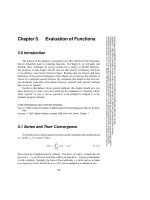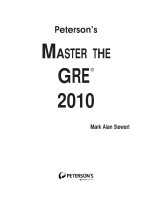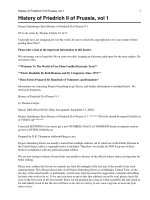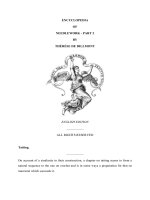ENCYCLOPEDIA OF NEEDLEWORK - PART 1 docx
Bạn đang xem bản rút gọn của tài liệu. Xem và tải ngay bản đầy đủ của tài liệu tại đây (41.73 MB, 376 trang )
ENCYCLOPEDIA
OF
NEEDLEWORK - PART 1
BY
THÉRÈSE DE DILLMONT
ENGLISH EDITION
ALL RIGHTS RESERVED
To be had:
of TH. DE DILLMONT, DORNACH, Alsace,
and at all booksellers, and embroidery shops.
Price, English bound with gilt edges:
English edition
Sh.
3.—
French edition
Fr.
5.75
German edition
Mk.
3.—
Preface.
The absolute want of any comprehensive book on needlework—such an one as
contains both verbal and pictorial descriptions of everything included under the name
of needlework—has led me to put into the serviceable form of an Encyclopedia, all
the knowledge and experience, which years of unceasing study and practice have
enabled me to accumulate on the subject, with the hope that diligent female workers
of all ages, may be able, by its means to instruct themselves in every branch of plain
and fancy needlework.
All the patterns given, even the most insignificant, were worked afresh for the
purpose, and thus, not merely faithful representations, but also lucid and intelligible
explanations of the same, are secured.
In order that my readers may have something besides the dull theory, the work is
enlivened by a number of useful patterns, some new, some derived from the artistic
productions of such countries and epochs as have become famous by special
excellence in the domain of needlework.
Though, at first sight, the reproduction of many of these patterns may seem to present
insuperable difficulties, they will, after a careful study of the text, and exact attention
to the directions given, prove easy to carry out.
Many of these interesting designs are drawn from private collections, whose owners,
with great kindness, placed their treasures at my disposal, to copy and borrow from at
discretion, for which I desire to take the present opportunity, of tendering them my
warmest thanks.
The choice of colours and material—a difficult matter to many—my readers will find
rendered comparatively easy to them by the notes affixed to the illustrations; and I
may point out, that most of the patterns were worked with D.M.C cottons, which
enjoy the well-earned reputation of being, the very best of their kind, in the market of
the world.
Experience has convinced me that, in many instances, these cottons may with
advantage take the place of wool, linen thread, and even silk.
If this work meet with indulgent judges, and prove really useful, I shall find ample
reward in that fact for the trouble and difficulties that have unavoidably attended its
completion.
Stripe showing running, stitching, button-holing, and herring-boning.
Plain Sewing.
Many, on opening the Encyclopedia of needlework will be disposed to exclaim as they
read the heading of this first section: What is the use of describing all the old well-
known stitches, when machines have so nearly superseded the slower process of hand-
sewing? To this our reply is that, of all kinds of needlework, Plain Sewing needs to be
most thoroughly learned, as being the foundation of all. Those who are able to employ
others to work for them, should at least know how to distinguish good work from bad,
and those who are in less fortunate circumstances, have to be taught how to work for
themselves.
Position of the body and hands.—Before describing different kinds of stitches, a
word should be said as to the position of the body and hands when at work. Long
experience has convinced me that no kind of needlework necessitates a stooping or
cramped attitude. To obviate which, see that your chair and table suit each other in
height, and that you so hold your work as hardly to need to bend your head at all. The
practice of fastening the work to the knee, besides being ungraceful, is injurious to the
health.
Needles.—These should be of the best quality. To test a needle, try to break it; if it
resist, and then break clean in two, the steel is good; if it bend without breaking, or
break without any resistance, it is bad. Never use a bent needle, it makes ugly and
irregular stitches, and see that the eye, whether round or egg-shaped, be well-drilled,
that it may not fray or cut the thread. Long or half-long needles are the best for white
work, long ones for dress-making, and longer ones still, with long eyes, for darning. A
stock of each, from No 5 to 12, is advised. The needle should always be a little thicker
than the thread, to make an easy passage for it through the stuff.
To keep needles from rusting, strew a little stone alum in the packets, and workers
whose hands are apt to get damp, should have a small box of it handy, to powder their
fingers with. Blackened needles can be made quite bright again by drawing them
through an emery cushion.
Scissors.—Scissors are a very important accessory of the work-table, and two
varieties are indispensable; a pair of large ones for cutting-out, with one point blunt
and the other sharp, the latter to be always held downwards; and a pair of smaller ones
with two sharp points. The handles should be large and round; if at all tight, they tire
and disfigure the hand.
Thimble.—Steel thimbles are the best; bone are very liable to break, and silver ones
are not deeply enough pitted, to hold the needle. A thimble should be light, with a
rounded top and flat rim.
The thread.—Except for tacking, your thread should never be more than from 40 to
50 c/m. long.[1] If the thread is in skeins, it does not matter which end you begin with,
but if you use reeled cotton, thread your needle with the end that points to the reel,
when you cut it; as the other end will split, and unravel, when twisted from left to
right, which is generally done, to facilitate the process of threading. The cotton should
always be cut, as it is weakened by breaking.
Knotting the thread into the needle (fig. 1).—When the thread becomes
inconveniently short, and you do not want take a fresh one, it may be knotted into the
needle, thus: bring it round the forefinger close to the needle, cross it on the inside
next to the finger, hold the crossed threads fast, with the thumb draw the needle out
through the loop thus formed, and tighten the loop round both ends.
Fig. 1.
Knotting the thread into the needle.
Materials.—For tacking, use Coton à coudre D.M.C qualité supérieure (black and
gold stamp) Nos. 2 to 6.[A] For hand-sewing, Fil d'Alsace D.M.C Nos. 30 to 700,[A]
and Fil à dentelle D.M.C, balls or reels, Nos. 25 to 100[A] will be found most useful.
For machine-work: Câblé 6 fils pour machines D.M.C, Nos. 30 to 300,[A] black and
white, or white and blue stamp. These can also be used for hand-work. Both these and
the lace-thread (Fil à dentelle) on reels, are superfine in quality. The medium sizes are
the most useful; but the only suitable ones for very fine and delicate fabrics are the Fil
à dentelle D.M.C, and Fil d'Alsace, and the latter only is manufactured in the higher
numbers.
All these threads are to be had, wound in balls, or on reels, the buyer may make his
own choice; balls are apt to get tangled, but the cotton preserves its roundness better
than when it is wound on reels. Linen is generally sewn with linen-thread, but Fil à
dentelle and the Fil d'Alsace are very good substitutes.
Position of the hands (fig. 2).—The stuff, fastened to a cushion, must be held with
the left hand, which should neither rest on the table, nor on the cushion, the needle
must be held between the thumb and forefinger, of the right hand, and the middle
finger, armed with the thimble, pushes the needle far enough through the stuff, for the
other fingers to take hold of it and draw it out; the thread then comes to lie between
the fourth and fifth fingers in the form of a loop, which must be tightened gradually to
avoid its knotting.
Fig. 2.
Position of the hands.
Position of the hands without cushion (fig. 3).—When the work cannot be fastened
to a cushion it should be held between the forefinger and the thumb, and left hanging
down, over the other fingers. If it need to be more firmly held, draw it between the
fourth and fifth fingers, which will prevent it from getting puckered or dragged.
Fig. 3.
Position of the hands without cushion.
Stitches.—Plain-Sewing comprises 4 varieties of stitches, (1) running, (2) back-
stitching, (3) hemming and (4) top or over-sewing.
(1) Running-stitch (fig. 4).—This is the simplest and easiest of all. Pass the needle in
and out of the material, at regular intervals, in a horizontal direction, taking up three or
four threads at a time. If the stuff allow, several stitches may be taken on the needle at
once, before the thread is drawn out. Running-stitch is used for plain seams, for
joining light materials, for making gathers and for hems.
Fig. 4. Running-stitch.
(2) Back-stitch (fig. 5).—Insert the needle, and draw it out six threads further on,
carry your thread back, from left to right, and insert the needle three threads back from
the point at which it was last drawn out, and bring it out six threads beyond. Stitching
and back-stitching are better and more quickly done by machine than by hand.
Fig. 5. Back-stitch.
Stitching (fig. 6).—The production of a row of back-stitches, that exactly meet one
another, constitutes what is called stitching. Only one stitch can be made at a time, and
the needle must be put in, exactly at the point where it was drawn out to form the
preceding back-stitch, and brought out as many threads further on as were covered by
the last back-stitch. The beauty of stitching depends on the uniform length of the
stitches, and the straightness of the line formed, to ensure which it is necessary to
count the threads for each stitch, and to draw a thread to mark the line. If you have to
stitch in a slanting line across the stuff, or the stuff be such as to render the drawing of
a thread impossible, a coloured tacking thread should be run in first, to as a guide.
Fig. 6. Stitching.
Stitched hem (fig. 7).—Make a double turning, as for a hem, draw a thread two or
three threads above the edge of the first turning, and do your stitching through all
three layers of stuff; the right side will be that on which you form your stitches.
Fig. 7. Stitched hem.
(3) Hemming-stitch (fig. 8).—To make a good hem, your stuff must be cut in the line
of the thread. Highly dressed stuffs, such as linen and calico; should be rubbed in the
hand, to soften them, before the hem is laid. Your first turning should not be more
than 2 m/m. wide; turn down the whole length of your hem, and then make the second
turning of the same width, so that the raw edge is enclosed between two layers of
stuff.
Fig. 8. Hemming-stitch.
Narrow hems do not need to be tacked, but wide ones, where the first turning should
only be just wide enough to prevent the edge from fraying, ought always to be. In
hemming you insert the needle and thread directed in a slanting position towards you,
just below the edge of the hem, and push it out two threads above, and so on to the
end, setting the stitches, two or three threads apart, in a continuous straight line. To
ensure the hem being straight, a thread may be drawn to mark the line for the second
turning, but it is not a good plan, especially in shirt-making, as the edge of the stuff,
too apt in any case, to cut and fray, is, thereby, still further weakened. Hems in
woollen materials, which will not take a bend, can only be laid and tacked, bit by bit.
In making, what are called rolled hems, the needle must be slipped in, so as only to
pierce the first turning, in order that the stitches may not be visible on the outside.
Flat seam (fig. 9).—Lay your two edges, whether straight or slanting, exactly even,
tack them together with stitches 2 c/m. long, distant 1 to 2 c/m. from the edge, and
then back-stitch them by machine or by hand, following the tacking-thread. Cut off
half the inner edge, turn the outer one in, as for a hem and sew it down with hemming-
stitches.
Fig. 9. Flat seam.
Smooth the seam underneath with the forefinger as you go, to make it lie quite flat.
Beginners should flatten down the seam with their thimbles, or with the handle of the
scissors, before they begin to hem, as the outer and wider edge is very apt to get
pushed up and bulge over, in the sewing, which hides the stitches.
Rounded seam.—Back-stitch your two edges together, as above directed, then cut off
the inner edge to a width of four threads, and roll the outer one in, with the left thumb,
till the raw edge is quite hidden, hemming as you roll. This kind of seam, on the
wrong side, looks like a fine cord, laid on, and is used in making the finer qualities of
underclothing.
Fastening threads off, and on (fig. 10).—Knots should be avoided in white work. To
fasten on, in hemming, turn the needle backwards with the point up, take one stitch,
and stroke and work the end of the thread in, underneath the turning. To fasten on, in
back-stitching or running, make one stitch with the new thread, then take both ends
and lay them down together to the left, and work over them, so that they wind in, and
out of the next few stitches.
Fig. 10. Fastening threads off and on.
(4) Top or over-sewing stitch (fig. 11).—This stitch is used for joining selvedges
together. To keep the two pieces even, it is better, either to tack or pin them together
first. Insert the needle, from right to left, under the first thread of the selvedge, and
through both edges, and sew from right to left, setting your stitches not more than
three threads apart. The thread must not be drawn too tightly, so that when the seam is
finished and flattened with the thimble, the selvedges may lie, side by side.
Fig. 11. Top or over-sewing stitch.
Another kind of sewing-stitch (fig. 12)—For dress-seams and patching; sew left to
right, tacking or pinning the edges together first, and holding them tightly with the
thumb and finger, to keep perfectly even.
Fig. 12. Another kind of sewing-stitch.
Antique or old-German seam (figs. 13 and 14).—Tack or pin the selvedges together
as above, then, pointing your needle upwards from below, insert it, two threads from
the selvedge, first on the wrong side, then on the right, first through one selvedge, then
through the other, setting the stitches two threads apart. In this manner, the thread
crosses itself, between the two selvedges, and a perfectly flat seam is produced. Seams
of this kind occur in old embroidered linen articles, where the stuff was too narrow to
allow for any other. A similar stitch, fig. 14, only slanting, instead of quite straight, as
in fig. 13, is used in making sheets.
Fig. 13. Antique or old-german seam.
Fig. 14. Antique or old german seam.
French double seam (fig. 15).—For joining such stuffs as fray, use the so-called
French-seam.
Run your two pieces of stuff together, the wrong sides touching, and the edges
perfectly even, then turn them round just at the seam, so that the right sides come
together inside, and the two raw edges are enclosed between, and run them together
again. See that no threads are visible on the outside. This seam is used chiefly in
dress-making, for joining slight materials together which cannot be kept from fraying
by any other means.
Fig. 15. French double-seam.
Hemmed double seam (figs. 16 and 17).—Turn in the two raw edges, and lay them
one upon the other, so that the one next the forefinger, lies slightly higher than the one
next the thumb. Insert the needle, not upwards from below but first into the upper
edge, and then, slightly slanting, into the lower one. This seam is used in dress-
making, for fastening down linings. Fig. 17 shows another kind of double seam, where
the two edges are laid together, turned in twice, and hemmed in the ordinary manner,
with the sole difference, that the needle has to pass through a sixfold layer of stuff.
Fig. 16. Hemmed double-seam.
Fig. 17. Open hemmed double-seam.
Gathering (fig. 18).—Gathers are made with running-stitches of perfectly equal
length; take up and leave three or four threads, alternately, and instead of holding the
stuff fast with your thumb, push it on to the needle as you go, and draw up your thread
after every four or five stitches.
Fig. 18. Gathering.
Stroking gathers (fig. 19).—When you have run in your gathering thread, draw it up
tight, and make it fast round the finger of your left hand, and then stroke down the
gathers with a strong needle, so that they lie evenly side by side, pushing each gather,
in stroking it, under your left thumb, whilst you support the stuff at the back with your
other fingers.
Fig. 19. Stroking gathers.
Running in a second gathering thread (fig. 20).—This is to fix the gathers after they
have been stroked, and should be run in 1 or 2 c/m. below the first thread, according to
the kind of stuff, and the purpose it is intended for: take up five or six gathers at a
time, and draw your two threads perfectly even, that the gathers may be straight to the
line of the thread.
Fig. 20. Running in a second gathering-thread.
Sewing on gathers (fig. 21).—To distribute the fulness equally, divide the gathered
portion of material, and the band, or plain piece, on to which it is to be sewn, into
equal parts, and pin the two together at corresponding distances, the gathered portion
under the plain, and hem each gather to the band or plain piece, sloping the needle to
make the thread slant, and slipping it through the upper threads only of the gathers.
Fig. 21. Sewing on gathers.
Whipping (fig. 22).—Whipping is another form of gathering, used for fine materials.
With the thumb and forefinger of the left hand, roll the edge over towards you, into a
very tight thin roll, insert the needle on the inside of the roll next the thumb, and bring
it out on the outside next the forefinger, at very regular distances, and draw up the
thread slightly, from time to time, to form the gathers.
Fig. 22. Whipping.
Ornamental hem (fig. 23). For an ornamental hem, make a turning, 2 or 3 c/m. deep,
and run in a thread, with small running-stitches up and down, as shown in fig. 23. By
slightly drawing the thread, the straight edge will be made to look as if it were
scalloped.
Fig. 23. Ornamental hem.
Sewing on cord (fig. 24).—For sewing on cord, use strong thread, either Fil d'Alsace
D.M.C, Fil à dentelle D.M.C or Câblé 6 fils D.M.C No. 25, 30, 35 or 40.
[A]
Be careful
not to stretch the cord, but to hold it in, as you sew it, as it invariably shrinks more
than the stuff in the first washing. Fasten it with hemming stitches to the edge of the
turning, taking care that it does not get twisted.
Fig. 24. Sewing on cord.
Sewing on flaps (fig. 25).—These should be back-stitched on to the right side of the
article they are to be affixed to, quite close to the edge, then folded over in half, and
hemmed down on the wrong side. Like the cord, the flap must, in the process, be held
in very firmly with the left hand. Though the back-stitching could be more quickly
done by machine, hand-work is here preferable, as the holding in cannot be done by
machine.
Fig. 25. Sewing on flaps.
Sewing on tape-loops (figs. 26 and 27).—These, in the case of the coarser articles of
household linen, are generally fastened to the corners. Lay the ends of your piece of
tape, which should be from 15 to 17 c/m. long, side by side, turn in and hem them
down, on three sides: the loop should be so folded as to form a three-cornered point,
shewn in the illustration. Join the two edges of the tape together in the middle with a
few cross-stitches, and stitch the edge of the hem of the article to the loop, on the right
side.
Fig. 26. Sewing on tape-loops to the corner.
Fig. 27. Sewing on tape-loops in the middle of the article.
Fig. 27 shows how to sew on a loop in the middle of an article, the two ends
separately, one on one side, the other on the other.
Strings and loops for fine under-linen (fig. 28).—Sew these on, likewise, on the
wrong side of the article, hemming down the ends, and fastening them on the right
side, with two rows of stitching crossing each other, and a third row along the edge.
Fig. 28. Strings and loops on fine under-linen.
Button-holes in linen (fig. 29).—Cut your hole perfectly straight, and of exactly, the
diameter of the button, having previously marked out the place for it, with two rows of
running-stitches, two or three threads apart. Put in your needle at the back of the slit,
and take up about three threads, bring the working thread round, from right to left
under the point of the needle, and draw the needle out through the loop, so that the
little knot comes at the edge of the slit, and so on to the end, working from the lower
left-hand corner to the right. Then make a bar of button-hole stitching across each end,
the knotted edge towards the slit.
Fig. 29. Button-holes in linen.
Button holes in dress materials (fig. 30).—Mark out and cut them as above
described; if however, the material be liable to fray, wet the slit as soon as you have
cut it, with liquid gum, and lay a strand of strong thread along the edge to make your
stitches over; one end of dress button-holes must be round, the stitches diverging like
rays from the centre, and when you have worked the second side, thread the needle
with the loose strand, and pull it slightly, to straighten the edges; then fasten off, and
close the button-hole with a straight bar of stitches across the other end, as in fig. 29.
Fig. 30. Button-holes in dress-materials.
Sewing on buttons (figs. 31 and 32).—To sew linen, or webbed buttons on to
underclothing, fasten in your thread with a stitch or two, at the place where the button
is to be; bring the needle out through the middle of the button, and make eight stitches,
diverging from the centre like a star, and if you like, encircle them by a row of
stitching, as in fig. 32. This done, bring the needle out between the stuff and the
button, and twist the cotton six or seven times round it, then push the needle through
to the wrong side, and fasten off.
Fig. 31. Sewing on linen buttons.
Fig. 32. Sewing on webbed buttons.
Binding slits (figs. 33, 34, 35, 36).—Nothing is more apt to tear than a slit whether it
be hemmed or merely bound. To prevent this, make a semicircle of button-hole
stitches at the bottom of the slit, and above that, to connect the two sides, a bridge of
several threads, covered with button-hole stitches.
In fig. 33, we show a hemmed slit, and in figs. 34 and 35, are two slits backed the one
with a narrow, the other, with a broad piece of the material, cut on the cross.
Fig. 33. Binding slits with hem.
Fig. 34. Binding slits with piece on cross.
Fig. 35. Binding slits with broad band.
Fig. 36. Strengthening slits with gusset.
In under-linen, it often so happens that two selvedges meet at the slit, which renders
binding unnecessary; in that case take a small square of stuff, turn in the raw edges,
top-sew it into the slit on two sides, turn in the other two, fold over on the bias, and
hem them down over the top-sewing, as shewn in fig. 36. Such little squares of
material, inserted into a slit or seam, to prevent its tearing, are called gussets.
Sewing on piping (fig. 37). Piping is a border, consisting of a cord or bobbin, folded
into a stripe of material, cut on the cross, and affixed to the edge of an article to give it
more strength and finish. It is a good substitute for a hem or binding on a bias edge,
which by means of the cord, can be held in, and prevented from stretching. Cut your
stripes diagonally, across the web of the stuff, and very even; run them together, lay
the cord or bobbin along the stripe, on the wrong side, 5 m/m. from the edge, fold the
edge over, and tack the cord lightly in. Then lay it on the raw edge of the article, with
the cord towards you, and with all the raw edges turned away from you. Back-stitch
the piping to the edge, keeping close to the cord. Then turn the article round, fold in
the raw outside edge over the others, and hem it down like an ordinary hem.
Fig. 37. Sewing on piping.
Fixing whale-bones (fig. 38).—Before slipping the whale-bone into its case or fold of
stuff, pierce holes in it, top and bottom, with a red hot stiletto. Through these holes,
make your stitches, diverging like rays or crossing each other as shown in fig. 38.
Fig. 38. Fixing whale-bones.
Herring-boning (fig. 39).—This stitch is chiefly used for seams in flannel, and for
overcasting dress-seams, and takes the place of hemming, for fastening down the raw
edges of a seam that has been run or stitched, without turning them in. Herring-boning
is done from left to right, and forms two rows of stitches. Insert the needle from right
to left, and make a stitch first above, and then below the edge, the threads crossing
each other diagonally, as shewn in fig. 39.
Fig. 39. Herring-boning
SPECIMENS OF PATTERN DARNS.
Mending.
The mending of wearing-apparel and house-linen, though often an ungrateful task, is
yet a very necessary one, to which every female hand ought to be carefully trained.
How best to disguise and repair the wear and tear of use or accident is quite as
valuable an art, as that of making new things.
Under the head of mending, we include the strengthening and replacing of the worn
and broken threads of a fabric, and fitting in of new stuff in the place of that which is
torn or damaged. The former is called darning, the latter, patching.
Darning.—When only a few of the warp or woof threads are torn or missing, a darn
will repair the mischief, provided the surrounding parts be sound. When the damage is
more extensive, the piece must be cut out.
In some cases the warp of the stuff itself can be used for darning, otherwise thread as
much like the stuff as possible should be chosen.
Materials suitable for mending.—Coton à repriser D.M.C is used for most kinds of
darning. It can be had in 18 different sizes, from Nos. 8 to 100, white and unbleached,
and in all the colours of the D.M.C colour-card in Nos. 12, 25 and 50.
It is but very slightly twisted and can be split or used double, if necessary, according
to the material. For all the coarser articles of house-linen, unbleached cotton is the
best, and for the finer white fabrics, Coton surfin D.M.C Nos. 110, 120 and 150[A].
This cotton, which is not the least twisted, and is to be had both white and unbleached,
can be used, by subdividing it, for darning the finest cambric.
Varieties of darning.—These are four, (1) Linen darning, (2) Damask darning, (3)
Satin or Twill darning, and (4) Invisible darning, called also, Fine-drawing.
(1) Linen Darning (figs. 40 and 41).—All darns should be made on the wrong side of
the stuff, excepting fig. 54, which it is sometimes better to make on the right side. The
longitudinal running, to form the warp, must be made first. The thread must not be
drawn tightly in running your stitches backwards and forwards, and be careful to leave
loops at each turning, to allow for the shrinking of the thread in the washing, without
its pulling the darn together.
Fig. 40. Linen darning. Drawing in the warp threads.
Run your needle in, about one c/m. above the damaged part, take up one or two
threads of the stuff and miss the same number, working straight to a thread; on
reaching the hole, carry your cotton straight across it, take up alternate threads
beyond, and proceed as before. Continue the rows backwards and forwards, taking up
in each row, the threads left in the preceding one. Turn the work round and do the
same for the woof; alternately taking up and leaving the warp threads, where the
cotton crosses the hole. The threads must lie so alone both ways, that the darn, when
completed, replaces the original web. The threads are only drawn so far apart in the
illustrations, for the sake of clearness.
Fig. 41. Linen darning. Drawing in the woof threads.
When the material to be darned does not admit of a fleecy thread, such as Coton à
repriser D.M.C, one that as nearly as possible matches the material, should be chosen
from the D.M.C cottons.[A]
Diagonal linen darning (fig. 42).—Darns are sometimes begun from the corner, so as
to form a diagonal web, but they are then much more visible than when they are
worked straight to a thread, and therefore not advisable.
Fig. 42. Diagonal linen darning.
(2) Satin or twill darning (fig. 43).—By twill darning, the damaged web of any
twilled or diagonal material can be restored. It would be impossible to enumerate all
the varieties of twilled stuffs, but the illustrations and accompanying directions will
enable the worker to imitate them all.
Fig. 43. Satin or twill darning.
Begin, as in ordinary darning by running in the warp threads, then take up one thread,
and miss three. In every succeeding row, advance one thread in the same direction. Or,
miss one thread of the stuff and take up two, and as before, advance, one thread in the
same direction, every succeeding row. The order in which threads should be missed
and taken up, must depend on the web which the darn is intended to imitate.
When the original is a coloured stuff, it is advisable to make a specimen darn first, on
a larger scale, so that you may be more sure of obtaining a correct copy of the original
web.
(3) Damask darning (figs. 44, 45, 46, 47, 48, 49).—A damask darn is begun in the
same way as all other darns are; the pattern is formed by the cross-runnings and will
vary with the number of warp threads taken up and missed, in each successive
running. The woven design which you are to copy with your needle must therefore be
carefully examined first.
Figs. 44 and 45 show the wrong and right sides of a damask darn, in process of being
made.
Fig. 44. Damask darning. Wrong side.
Fig. 45. Damask darning. Right side.
Fig. 46 represents a completed one. In the case of coloured webs, a light shade of
cotton is generally used for the warp, one that matches the stuff, for the shot or woof.
Fig. 46. Damask darning. Covered ground.
Figs. 47 and 48, illustrate two specimens of darning, formerly done in the convents,
from which it will be seen, that the warp and the woof were first drawn in with rather
fine thread and the pattern then worked into this foundation with coarser, or else,
coloured thread. When this kind of darn is in two colours, take, for the darker shade,
Coton à broder D.M.C, or Coton à repriser D.M.C, which are both of them to be had
in all the bright and faded shades, to match alike both old and new linen.
Fig. 47. Damask darning on needle-made ground.
Fig. 48. Damask darning on needle-made ground.
Fig. 49, which is executed in two colours, and is likewise copied from an old work on
darning, shows you the manner in which a dice-pattern is to be reproduced.









